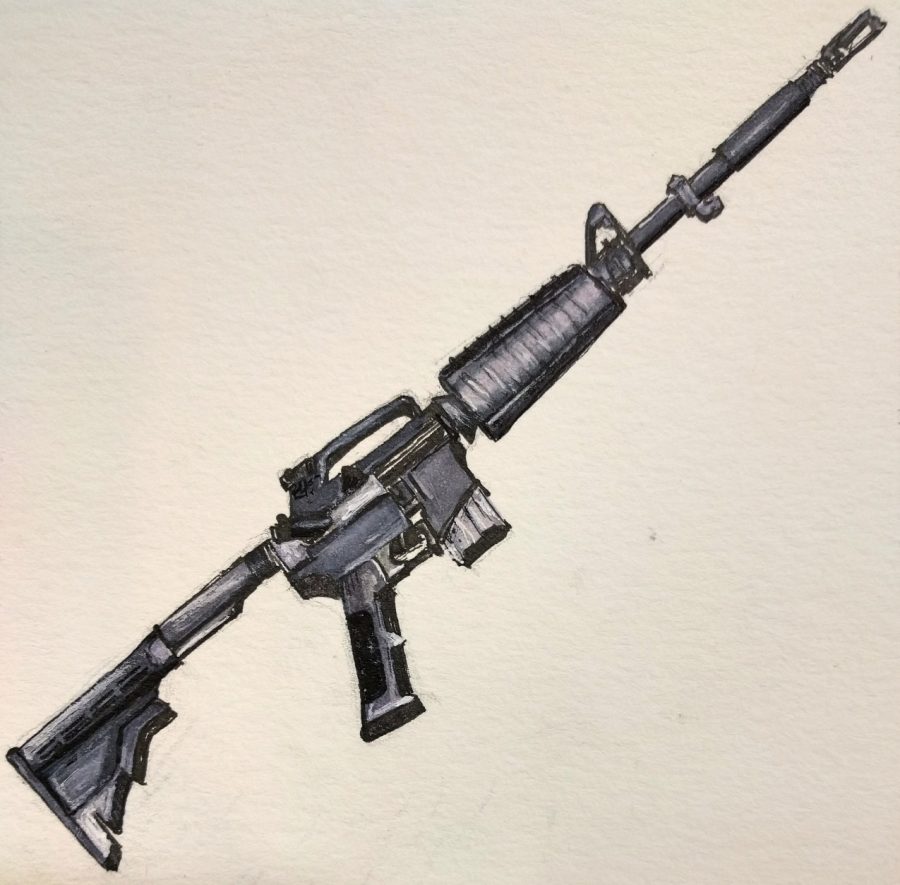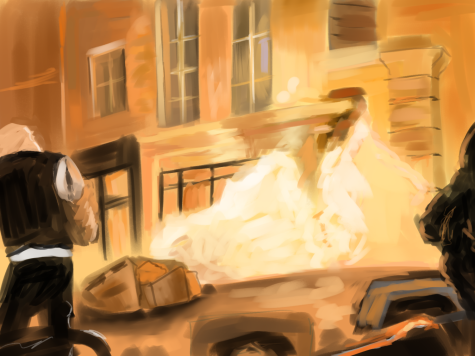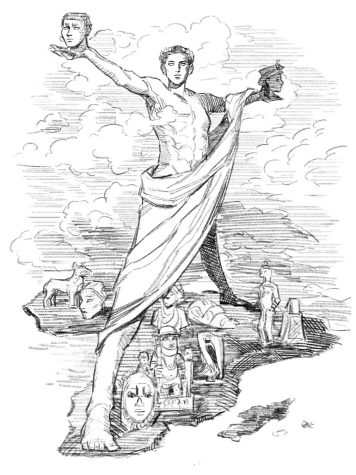The Tragedy in Parkland: Guns and Grief
April 9, 2018
Students are in class during the last period of the day at Marjory Stoneman Douglas High School, and the bell will ring in ten minutes. Suddenly, the sound of a fire alarm rings out into the air for the second time that day. Confusion spreads among the students. There has already been a fire drill today, so why is the alarm ringing again? Nonetheless, some students vacate their seats and make their way out into the hallway. Not long after, the sound of a semi-automatic .223-caliber AR-15 rifle rings out in the halls. Panic ensues. Terrified, some students film the chaos. Some send their families what they fear will be their last words. By the time the gunshots stop, fifteen people are dead and seventeen others wounded [1].
This was the reality that students experienced on February 14th, when an active shooter–19-year-old Nikolas Cruz, a former student at the high school–broke into the east stairwell of Marjory Stoneman’s Building 12 at 2:19 PM, pulling the fire alarm to draw students out of their classrooms. Four minutes later, the first shots rang out when Cruz shot into the first of four classrooms on the bottom floor, later making his way up to the second floor, firing into one of the classrooms there, then going up to the third floor, and finally exiting the building without targeting any of the classrooms there. Dropping the rifle and its case, he left, blending in with fleeing students and teachers who had begun to exit the school upon hearing the gunshots, many with their hands in the air [1]. In total, the death toll amounted to seventeen people, two of whom died at hospitals. Among them were three staff members and fourteen students, ranging in age from 14 to 49 [2].
At 3:41 PM, authorities apprehended Cruz. After having left the building, he purchased a drink at a Subway in a Walmart, sat in a McDonald’s for a few minutes, and finally made his way down a street in a nearby residential neighborhood. Reportedly, he surrendered without incident [1]. Upon the arrival of authorities at the school, those who had gotten wounded were evacuated, while parents and family members of students reunited with them outside the school and at a nearby Marriott hotel [3].
The next day, Cruz confessed responsibility for the shooting, and was charged with seventeen counts of premeditated murder. It was announced that Marjory Stoneman was to remain closed for the time being, while the nearby middle school, Westglades Middle School, was to remain open, with grief counselors stationed nearby to help students, their family members, and the staff at Marjory Stoneman [4]. Following this development, students and teachers immediately began to lobby for stricter gun control laws, sparking a nationwide gun control debate.
Following the shooting, President Trump promised to take action after student survivors issued calls for action regarding stricter gun control and tighter school security; he cited background checks, mental health services, and tighter school security as potential avenues for improvement, a contrast from a promise preceding the Parkland shooting to stand behind the National Rifle Association (NRA), instead stating that he would like to reach a compromise between unrestricted gun ownership and strict gun control [5] [6] [7]. However, activists have been quick to point out that a sheriff’s deputy assigned to Marjory Stoneman, Scot Peterson, had been in uniform as well as armed and was on campus during the attack–but failed to enter the school building or engage the gunman, remaining outside for over four minutes [8].
Later, President Trump elaborated further, suggesting that a possible solution might be to arm teachers in order to “deter” potential school shooters from targeting schools, as well as improved security, mental health measures, and background checks, suggesting that a bill for universal background checks be revived [5]. He continued on to propose a ban for bump stocks, which are gun accessories used to accelerate a gun’s fire until it is comparable to that of an automatic weapon, eventually submitting a notice of a proposed regulation to ban bump stocks to the Office of Management and Budget [15]. However, students at Marjory Stoneman have raised an outcry about his inaction, in addition to his statement that the FBI was at fault, supposedly because it was preoccupied in investigating Russia and its impact on the 2016 presidential election, making it unable to identify Nikolas Cruz as a threat before he became a school shooter [9].
The president’s response to the shooting has become a part of a larger debate nationwide–that of gun control. As has occurred in the past following school shootings, advocates of stricter gun control as well as student survivors have taken action–and a large percentage of Americans now hold the same views. A poll from Politico returned that 88% of Americans support universal background checks, 81% are in favor of raising the minimum age for gun ownership to 21 years, 70% agree with a ban on high-capacity magazines, and finally that 68% back a ban on assault-style weapons [5].
Following the shooting, the NRA has spoken out as well, with chief executive Wayne LaPierre slamming gun control advocacy and media coverage of the shootings and the organization itself releasing a video accusing the media of using mass shootings to increase their ratings. LaPierre also stated that tighter school security would solve the problem, echoing the views of President Trump. In addition to releasing statements, NRA spokeswoman Dana Loesch also attended the recent CNN-hosted town hall debate, where she and Florida senator Marco Rubio went head-to-head with student survivors from Marjory Stoneman. Loesch criticized both the background check system in place for prospective firearms as well as the FBI, stating of the latter that it was inept in protecting citizens [10]. Rubio made several statements, including that he supported raising the minimum age for prospective gun owners, changing the size of gun magazines, and the concept of a “gun violence restraining order,” where people might be barred access from guns, and that he was against arming teachers [13].
Fiona He suggests that the solution can “start with the assault weapons because those have no reason being in the public as they were designed for war,” citing what has now become a majority viewpoint in the U.S. based upon recent polling results.
In addition to changing views nationwide, student survivors have also begun organizing protests, marches, and rallies, a movement that has spread across the country via social media [11]. One of the larger movements is the March for Our Lives, to take place on March 24th, in Washington, D.C. In addition to the central one in Washington, there are several smaller marches planned in cities such as Los Angeles, California; Chicago, Illinois; and Liverpool, England, among others [12].
However, even as students have taken this opportunity to speak out and hopefully make a difference, accusations have abounded about students being so-called “crisis actors,” individuals supposedly paid to travel to different locations where mass shootings have occurred and coached to speak out for stricter gun regulations. Conspiracy theories allege that gun control groups pay for these crisis actors. In light of these accusations, however, students have a received a lot of support online and continue to lobby for change [14].
On the recent efforts of students, Austin Segal ‘20 remarks, “I find it inspiring that students are taking a stand to protect safe environments for their education. If we want a change, no one can fight that battle but us,” echoing the sentiments of Marjory Stoneman students taking action themselves in lieu of officials, determined to take advantage of the atmosphere while it remains conducive to change.
[1]https://www.cnn.com/2018/02/18/us/parkland-florida-school-shooting-accounts/index.html
[2]https://www.cnn.com/2018/02/15/us/florida-shooting-victims-school/index.html
[3]https://www.nytimes.com/2018/02/14/us/parkland-school-shooting.html
[4]http://time.com/5158678/what-to-know-about-the-active-shooter-situation-at-florida-high-school/
[5]https://www.newyorker.com/magazine/2018/03/12/the-gun-control-debate-after-parkland
[9]https://www.cnn.com/2018/02/18/politics/donald-trump-florida-shooting-twitter/index.html
[11]https://www.theatlantic.com/politics/archive/2018/02/parkland-students-power/554399/
[12]http://time.com/5167102/march-for-our-lives-parkland-school-shooting-protest/
[13]https://www.cnn.com/2018/02/22/politics/marco-rubio-gun-debate-cnn-town-hall/index.html
[14]https://www.cnn.com/2018/02/21/us/david-hogg-conspiracy-theories-response/index.html



